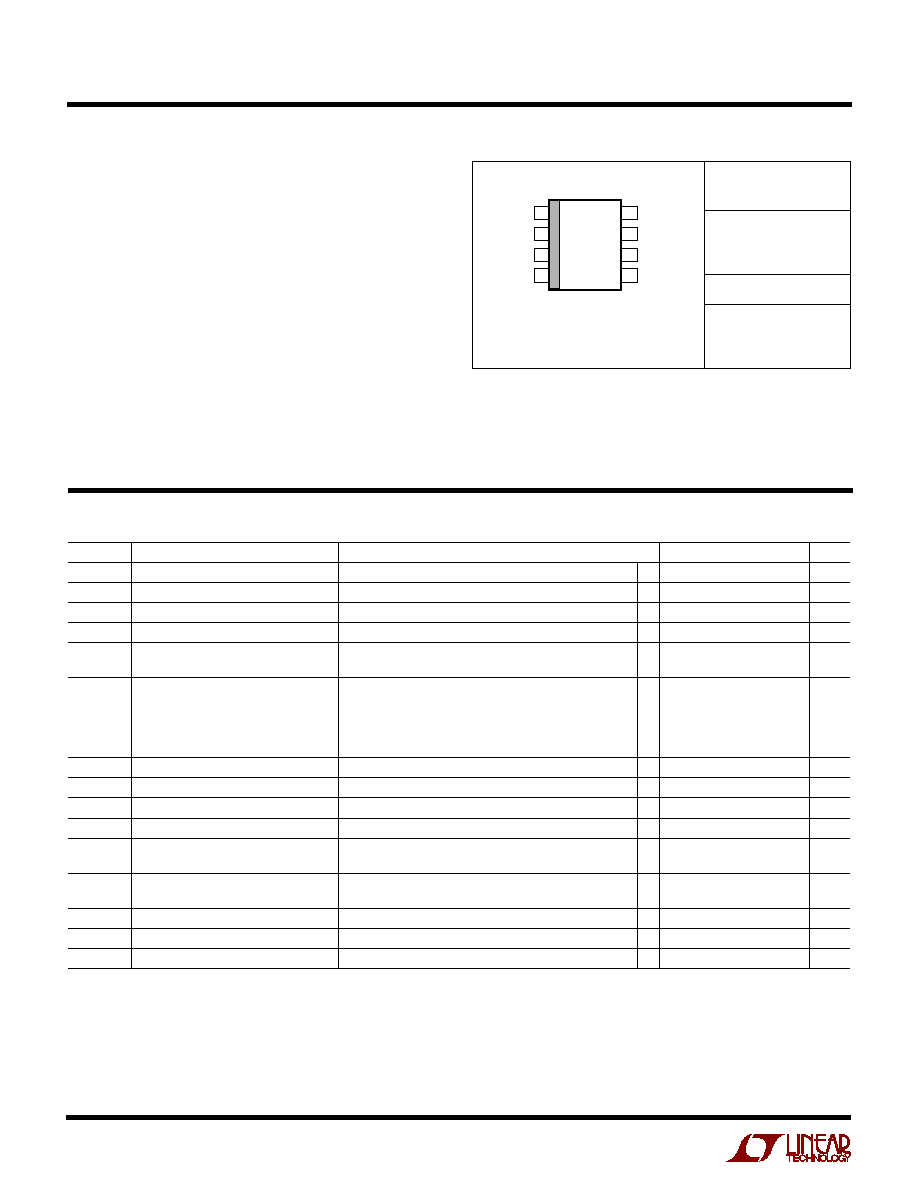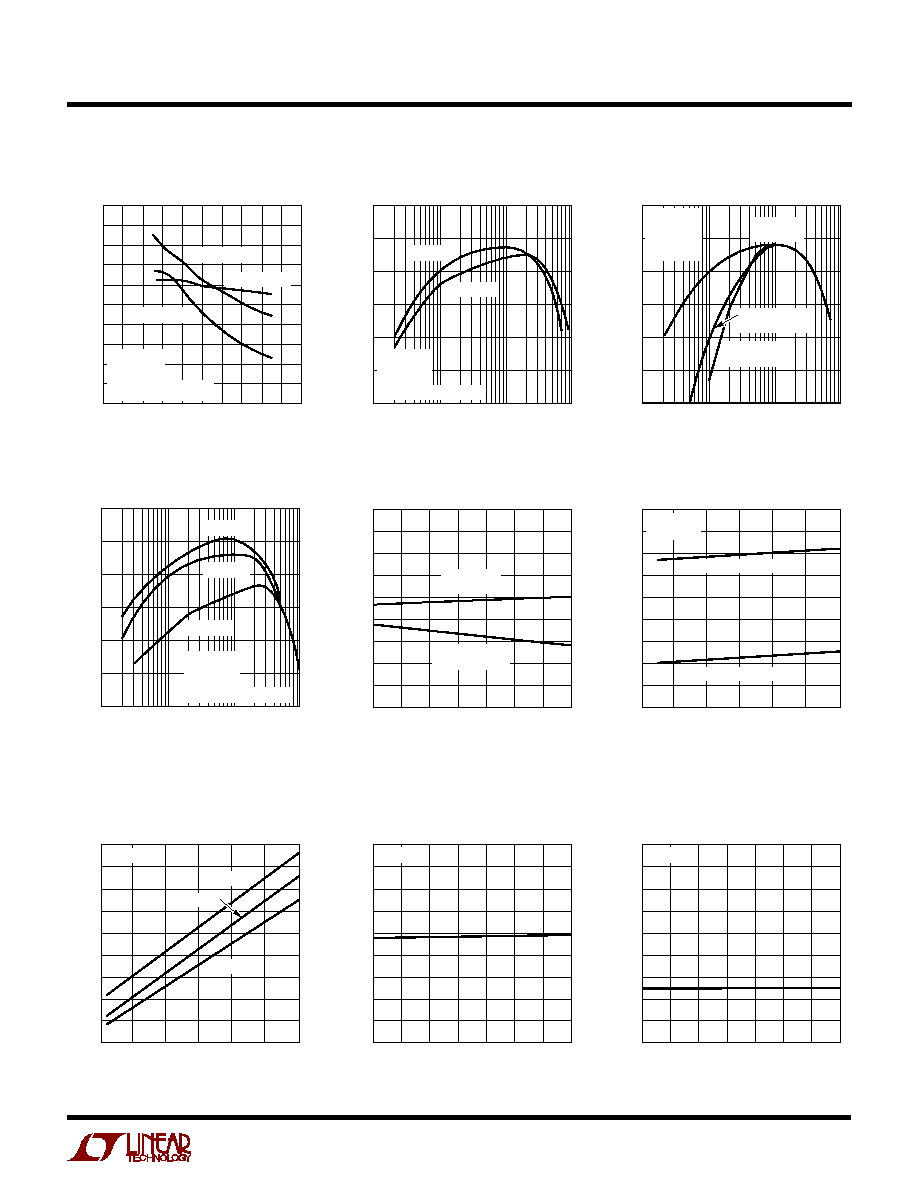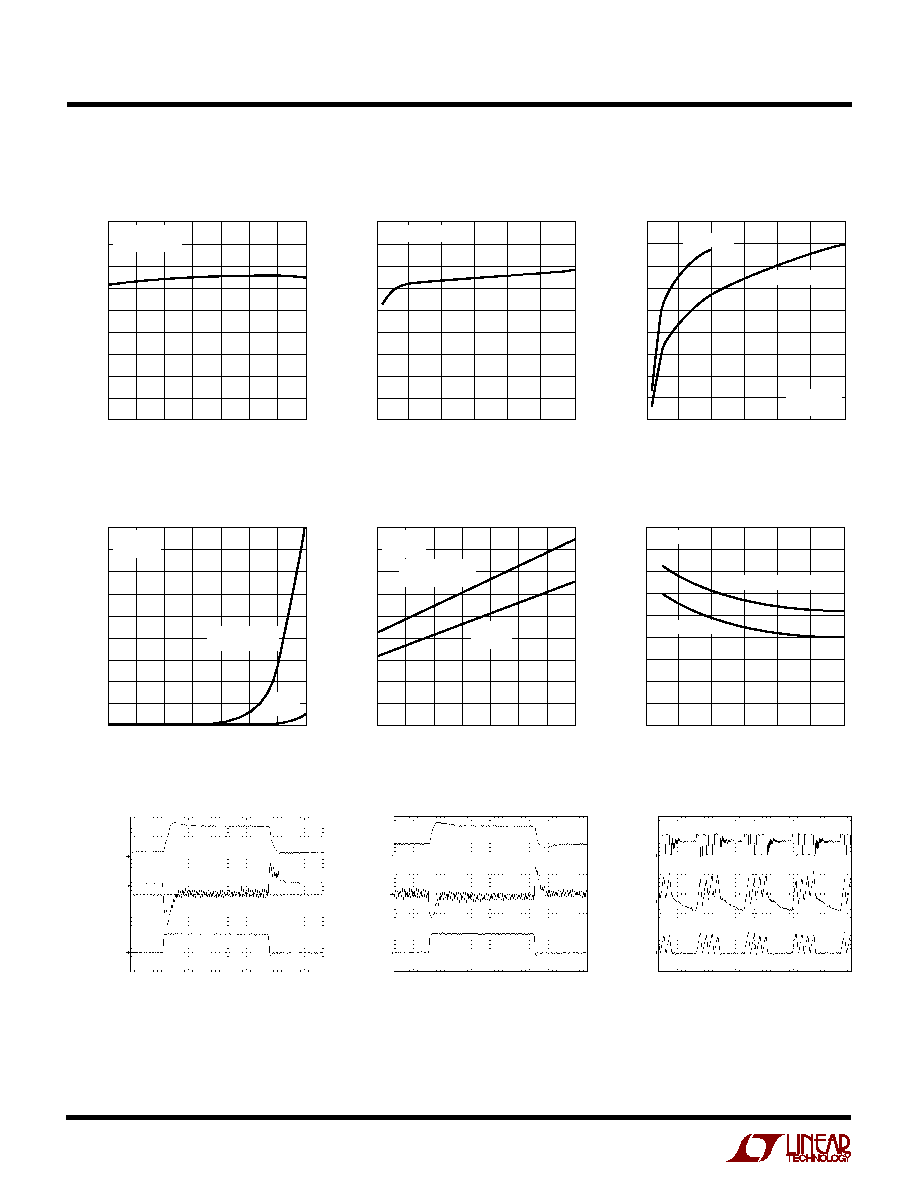 | ÐлекÑÑоннÑй компоненÑ: LTC1627 | СкаÑаÑÑ:  PDF PDF  ZIP ZIP |
Äîêóìåíòàöèÿ è îïèñàíèÿ www.docs.chipfind.ru

1
LTC1627
Monolithic Synchronous
Step-Down Switching Regulator
Figure 1b. Efficiency vs Output Load Current
Figure 1a. High Efficiency Step-Down Converter
FEATURES
DESCRIPTIO
N
U
The LTC
®
1627 is a monolithic current mode synchronous
buck regulator using a fixed frequency architecture. The
operating supply range is from 8.5V down to 2.65V, making
it suitable for one or two lithium-ion battery-powered appli-
cations. Burst Mode operation provides high efficiency at
low load currents. 100% duty cycle provides low dropout
operation, which extends operating time in battery-operated
systems.
The operating frequency is internally set at 350kHz, allowing
the use of small surface mount inductors. For switching noise
sensitive applications it can be externally synchronized up to
525kHz. The SYNC/FCB control pin guarantees regulation of
secondary windings regardless of load on the main output by
forcing continuous operation. Burst Mode operation is inhib-
ited during synchronization or when the SYNC/FCB pin is
pulled low to reduce noise and RF interference. Soft-start is
provided by an external capacitor.
Optional bootstrapping enhances the internal switch drive for
single lithium-ion cell applications. The internal synchronous
switch increases efficiency and eliminates the need for an
external Schottky diode, saving components and board
space. The LTC1627 comes in an 8-lead SO package.
L1 15
µ
H
C
OUT
100
µ
F
6.3V
80.6k
249k
47pF
V
IN
2.8V*
TO 8.5V
V
OUT
3.3V
1627 F01a
C
SS
0.1
µ
F
C
IN
22
µ
F
16V
1
2
3
4
8
7
6
5
SYNC/FCB
V
DR
V
IN
SW
I
TH
RUN/SS
V
FB
GND
LTC1627
+
+
*V
OUT
CONNECTED TO V
IN
FOR 2.8V < V
IN
< 3.3V
OUTPUT CURRENT (mA)
1
70
EFFICIENCY (%)
90
95
100
10
100
1000
1627 F01b
85
80
75
V
OUT
= 3.3V
V
IN
= 6V
V
IN
= 3.6V
V
IN
= 8.4V
s
High Efficiency: Up to 96%
s
Constant Frequency 350kHz Operation
s
2.65V to 8.5V V
IN
Range
s
V
OUT
from 0.8V to V
IN
, I
OUT
to 500mA
s
No Schottky Diode Required
s
Synchronizable Up to 525kHz
s
Selectable Burst Mode
TM
Operation
s
Low Dropout Operation: 100% Duty Cycle
s
Precision 2.5V Undervoltage Lockout
s
Secondary Winding Regulation
s
Current Mode Operation for Excellent Line and
Load Transient Response
s
Low Quiescent Current: 200
µ
A
s
Shutdown Mode Draws Only 15
µ
A Supply Current
s
±
1.5% Reference Accuracy
s
Available in 8-Lead SO Package
APPLICATIO
N
S
U
s
Cellular Telephones
s
Portable Instruments
s
Wireless Modems
s
RF Communications
s
Distributed Power Systems
s
Scanners
s
Single and Dual Cell Lithium
TYPICAL APPLICATIO
N
U
, LTC and LT are registered trademarks of Linear Technology Corporation.
Burst Mode is a trademark of Linear Technology Corporation.

2
LTC1627
T
JMAX
= 125
°
C,
JA
= 110
°
C/ W
ORDER PART
NUMBER
ABSOLUTE
M
AXI
M
U
M
RATINGS
W
W
W
U
PACKAGE/ORDER I
N
FOR
M
ATIO
N
W
U
U
S8 PART MARKING
TOP VIEW
SYNC/FCB
V
DR
V
IN
SW
I
TH
RUN/SS
V
FB
GND
S8 PACKAGE
8-LEAD PLASTIC SO
1
2
3
4
8
7
6
5
Consult factory for Military grade parts.
(Note 1)
Input Supply Voltage ................................ 0.3V to 10V
Driver Supply Voltage (V
IN
V
DR
) ........... 0.3V to 10V
I
TH
Voltage .................................................. 0.3V to 5V
Run/SS, V
FB
Voltages ................................ 0.3V to V
IN
Sync/FCB Voltage ...................................... 0.3V to V
IN
V
DR
Voltage (V
IN
5V) ............................... 5V to 0.3V
P-Channel Switch Source Current (DC) .............. 800mA
N-Channel Switch Sink Current (DC) .................. 800mA
Peak SW Sink and Source Current.......................... 1.5A
Operating Ambient Temperature Range
Commercial ............................................ 0
°
C to 70
°
C
Industrial ........................................... 40
°
C to 85
°
C
Junction Temperature (Note 2) ............................. 125
°
C
Storage Temperature Range ................. 65
°
C to 150
°
C
Lead Temperature (Soldering, 10 sec).................. 300
°
C
1627
1627I
T
A
= 25
°
C, V
IN
= 5V unless otherwise specified.
ELECTRICAL CHARACTERISTICS
SYMBOL
PARAMETER
CONDITIONS
MIN
TYP
MAX
UNITS
I
VFB
Feedback Current
(Note 3)
20
60
nA
V
FB
Regulated Feedback Voltage
(Note 3)
q
0.788
0.80
0.812
V
V
OVL
Output Overvoltage Lockout
V
OVL
= V
OVL
V
FB
20
60
110
mV
V
FB
Reference Voltage Line Regulation
V
IN
= 2.8V to 8.5V (Note 3)
0.002
0.01
%/V
V
LOADREG
Output Voltage Load Regulation
I
TH
Sinking 2
µ
A (Note 3)
0.5
0.8
%
I
TH
Sourcing 2
µ
A (Note 3)
0.5
0.8
%
I
S
Input DC Bias Current
(Note 4)
Synchronized
V
IN
= 8.5V, V
OUT
= 3.3V, Frequency = 525kHz
450
µ
A
Burst Mode Operation
V
ITH
= 0V, V
IN
= 8.5V, V
SYNC/ FCB
= Open
200
320
µ
A
Shutdown
V
RUN/SS
= 0V, 2.65V < V
IN
< 8.5V
15
35
µ
A
Shutdown
V
RUN/SS
= 0V, V
IN
< 2.65V
6
µ
A
V
RUN/SS
Run/SS Threshold
0.4
0.7
1.0
V
I
RUN/SS
Soft-Start Current Source
V
RUN/SS
= 0V
1.2
2.25
3.3
µ
A
V
SYNC/FCB
Auxiliary Feedback Threshold
V
SYNC/FCB
Ramping Negative
0.755
0.8
0.835
V
I
SYNC/FCB
Auxiliary Feedback Current
V
SYNC/FCB
= 0V
0.5
1.5
2.5
µ
A
f
OSC
Oscillator Frequency
V
FB
= 0.8V
315
350
385
kHz
V
FB
= 0V
35
kHz
V
UVLO
Undervoltage Lockout
V
IN
Ramping Down from 3V
q
2.4
2.50
2.65
V
V
IN
Ramping Up from 0V
q
2.65
2.80
V
R
PFET
R
DS(ON)
of P-Channel FET
(V
IN
V
DR
) = 5V, I
SW
= 100mA
0.5
0.7
R
NFET
R
DS(ON)
of N-Channel FET
I
SW
= 100mA
0.6
0.8
I
LSW
SW Leakage
V
RUN/SS
= 0V
±
10
±
1000
nA
The
q
denotes specifications which apply over the full operating
temperature range.
Note 1: Absolute Maximum Ratings are those values beyond which the life
of a device may be impaired.
Note 2: T
J
is calculated from the ambient temperature T
A
and power
dissipation P
D
according to the following formula:
T
J
= T
A
+ (P
D
· 110
°
C/W)
Note 3: The LTC1627 is tested in a feedback loop that servos V
FB
to the
balance point for the error amplifier (V
ITH
= 0.8V).
Note 4: Dynamic supply current is higher due to the gate charge being
delivered at the switching frequency.
LTC1627CS8
LTC1627IS8

3
LTC1627
TYPICAL PERFOR A CE CHARACTERISTICS
U
W
INPUT VOLTAGE (V)
0
EFFICIENCY (%)
90
95
100
8
1627 G01
85
80
75
2
4
6
10
V
OUT
= 2.5V
L = 15
µ
H
V
DR
= 0V
Burst Mode OPERATION
I
LOAD
= 100mA
I
LOAD
= 300mA
I
LOAD
= 10mA
Efficiency vs Input Voltage
OUTPUT CURRENT (mA)
1
70
EFFICIENCY (%)
90
95
100
10
100
1000
1627 G03
85
80
75
V
IN
= 3.6V
V
OUT
= 2.5V
L = 15
µ
H
V
DR
= 0V
Burst Mode
OPERATION
SYNCHRONIZED
AT 525kHz
FORCED
CONTINUOUS
OUTPUT CURRENT (mA)
1
70
EFFICIENCY (%)
90
95
100
10
100
1000
1627 G02
85
80
75
V
IN
= 3.6V
V
OUT
= 2.5V
L = 15
µ
H
Burst Mode OPERATION
V
DR
= 0V
V
DR
= V
IN
Efficiency vs Load Current
Efficiency vs Load Current
Undervoltage Lockout Threshold
vs Temperature
DC Supply Current*
vs Input Voltage
Efficiency vs Load Current
OUTPUT CURRENT (mA)
1
70
EFFICIENCY (%)
90
95
100
10
100
1000
1627 G04
85
80
75
V
OUT
= 2.5V
L = 15
µ
H
V
DR
= 0V
Burst Mode OPERATION
V
IN
= 2.8V
V
IN
= 3.6V
V
IN
= 7.2V
TEMPERATURE (
°
C)
50
25
2.30
UNDERVOLTAGE LOCKOUT THRESHOLD (V)
2.35
2.45
2.50
2.55
75
100
2.75
1627 G05
2.40
0
25
50
125
2.60
2.65
2.70
V
IN
RAMPING UP
V
IN
RAMPING DOWN
INPUT VOLTAGE (V)
*DOES NOT INCLUDE GATE CHARGE CURRENT
2.5
100
BATTERY VOLTAGE (V)
150
250
300
350
6.5
550
1627 G06
200
4.5
3.5
7.5
5.5
8.5
400
450
500
T
J
= 25
°
C
V
OUT
= 1.8V
SYNCHRONIZED AT 525kHz
Burst Mode OPERATION
Reference Voltage
vs Temperature
Forced Continuous Threshold
Voltage vs Temperature
Supply Current in Shutdown
vs Input Voltage
TEMPERATURE (
°
C)
50
25
0.790
REFERENCE VOLTAGE (V)
0.792
0.796
0.798
0.800
75
100
0.808
1627 G08
0.794
0
25
50
125
0.802
0.804
0.806
V
IN
= 5V
TEMPERATURE (
°
C)
50
25
0.790
FORCED CONTINUOUS THRESHOLD VOLTAGE (V)
0.792
0.796
0.798
0.800
75
100
0.808
1627 G09
0.794
0
25
50
125
0.802
0.804
0.806
V
IN
= 5V
INPUT VOLTAGE (V)
2.5
4
SUPPLY CURRENT IN SHUTDOWN (
µ
A)
6
10
12
14
6.5
22
1627 G07
8
4.5
3.5
7.5
5.5
8.5
16
18
20
V
RUN/SS
= 0V
T
J
= 85
°
C
T
J
= 25
°
C
T
J
= 40
°
C

4
LTC1627
TYPICAL PERFOR A CE CHARACTERISTICS
U
W
Oscillator Frequency
vs Temperature
TEMPERATURE (
°
C)
50
25
300
OSCILLATOR FREQUENCY (kHz)
310
330
340
350
75
100
390
1627 G10
320
0
25
50
125
360
370
380
V
IN
= 5V
V
SYNC/FCB
= 0V
Maximum Output Load Current
vs Input Voltage
INPUT VOLTAGE (V)
2.5
200
MAXIMUM OUTPUT LOAD CURRENT (mA)
300
500
600
700
6.5
1100
1627 G12
400
4.5
3.5
7.5
5.5
8.5
800
900
1000
V
DR
= V
IN
V
DR
= 0V
V
OUT
= 2.5V
L = 15
µ
H
INPUT VOLTAGE (V)
2.5
300
OSCILLATOR FREQUENCY (kHz)
310
330
340
350
6.5
390
1627 G11
320
4.5
3.5
7.5
5.5
8.5
360
370
380
V
SYNC/FCB
= 0V
Oscillator Frequency
vs Input Voltage
TEMPERATURE (
°
C)
50
25
0
SYNCHRONOUS SWITCH LEAKAGE (nA)
200
600
800
1000
75
100
1800
1627 G13
400
0
25
50
125
1200
1400
1600
V
IN
= 8.4V
V
DR
= 0V
SYNCHRONOUS
SWITCH
MAIN
SWITCH
Switch Leakage Current
vs Temperature
Switch Resistance
vs Temperature
TEMPERATURE (
°
C)
50
25
0
SWITCH RESISTANCE (
)
0.1
0.3
0.4
0.5
75
100
0.9
1627 G14
0.2
0
25
50
125
0.6
0.7
0.8
V
IN
= 5V
V
DR
= 0V
SYNCHRONOUS
SWITCH
MAIN
SWITCH
Switch Resistance
vs Input Voltage
INPUT VOLTAGE (V)
2.5
0
SWITCH RESISTANCE (
)
0.1
0.3
0.4
0.5
6.5
0.9
1627 G15
0.2
4.5
3.5
7.5
5.5
8.5
0.6
0.7
0.8
V
DR
= 0V
SYNCHRONOUS SWITCH
MAIN SWITCH
Load Step Transient Response
V
OUT
50mV/DIV
AC COUPLED
I
TH
0.5V/DIV
I
LOAD
500mA/DIV
25
µ
s/DIV
V
IN
= 5V
V
OUT
= 3.3V
L = 15
µ
H
C
IN
= 22
µ
F
C
OUT
= 100
µ
F
I
LOAD
= 0mA TO 500mA
Burst Mode OPERATION
1627 G16
V
OUT
20mV/DIV
AC COUPLED
I
LOAD
200mA/DIV
10
µ
s/DIV
V
IN
= 5V
V
OUT
= 3.3V
L = 15
µ
H
C
IN
= 22
µ
F
C
OUT
= 100
µ
F
I
LOAD
= 50mA
1627 G18
V
OUT
50mV/DIV
AC COUPLED
I
TH
0.5V/DIV
I
LOAD
500mA/DIV
25
µ
s/DIV
V
IN
= 5V
V
OUT
= 3.3V
L = 15
µ
H
C
IN
= 22
µ
F
C
OUT
= 100
µ
F
I
LOAD
= 0mA TO 500mA
FORCED CONTINUOUS MODE
1627 G17
Load Step Transient Response
Burst Mode Operation
SW
5V/DIV

5
LTC1627
PI
N
FU
N
CTIO
N
S
U
U
U
I
TH
(Pin 1): Error Amplifier Compensation Point. The
current comparator threshold increases with this control
voltage. Nominal voltage range for this pin is 0V to 1.2V.
RUN/SS (Pin 2): Combination of Soft-Start and Run
Control Inputs. A capacitor to ground at this pin sets the
ramp time to full current output. The time is approximately
0.5s/
µ
F. Forcing this pin below 0.4V shuts down all the
circuitry.
V
FB
(Pin 3): Feedback Pin. Receives the feedback voltage
from an external resistive divider across the output.
GND (Pin 4): Ground Pin.
SW (Pin 5): Switch Node Connection to Inductor. This pin
connects to the drains of the internal main and synchro-
nous power MOSFET switches.
V
IN
(Pin 6):
Main Supply Pin. Must be closely decoupled
to GND, Pin 4.
V
DR
(Pin 7): Top Driver Return Pin. This pin can be
bootstrapped to go below ground to improve efficiency at
low V
IN
(see Applications Information).
SYNC/FCB (Pin 8): Multifunction Pin. This pin performs
three functions: 1) secondary winding feedback input, 2)
external clock synchronization and 3) Burst Mode opera-
tion or forced continuous mode select. For secondary
winding applications connect a resistive divider from the
secondary output. To synchronize with an external clock
apply a TTL/CMOS compatible clock with a frequency
between 385kHz and 525kHz. To select Burst Mode opera-
tion, float the pin or tie it to V
IN
. Grounding Pin 8 forces
continuous operation (see Applications Information).
FU
N
CTIO
N
AL DIAGRA
U
U
W
V
FB
V
IN
3
2
1
6
7
5
4
Q
Q
R
S
0.12V
SWITCHING
LOGIC
AND
BLANKING
CIRCUIT
0.6V
I
TH
RUN/SS
0.8V
0.4V
0.86V
SYNC/FCB
Y = "0" ONLY WHEN X IS A CONSTANT "1"
SHUTDOWN
SLEEP
6
1.5
µ
A
2.25
µ
A
V
IN
V
IN
V
IN
V
IN
V
DR
SW
GND
1627 BD
V
IN
0.8V
BURST
EN
8
OSC
FREQ
SHIFT
0.8V
REF
UVLO
TRIP = 2.5V
Y
X
BURST
DEFEAT
SLOPE
COMP
+
OVDET
+
+
+
+
+
+
EA
I
COMP
+
I
RCMP
RUN/SOFT
START
FCB
ANTI-
SHOOT-THRU




